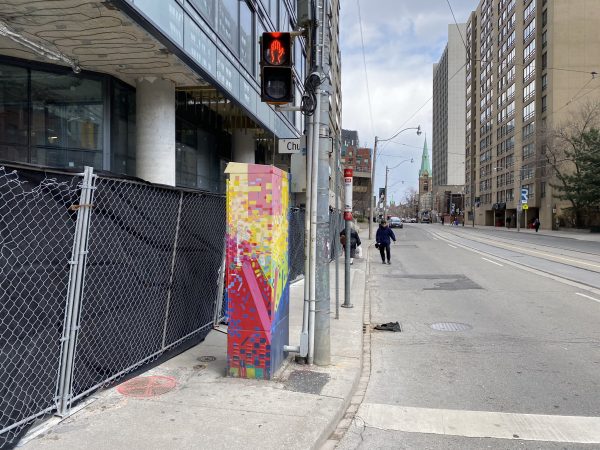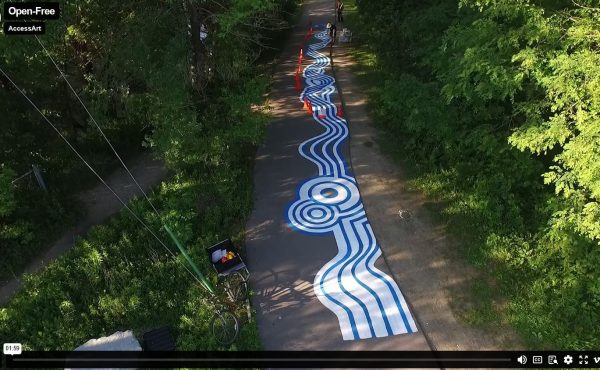In the coming weeks and months, we will have the luxury and the obligation to worry about challenges in addition to the threat of COVID-19. Sooner rather than later Toronto must return to dealing with the limitations of our transportation infrastructure. On roads, among other things, we have two key challenges, 1) how can the city support wise physical distancing choices now, and 2) what choices now will give us a better city ‘after’?
On the now front, Toronto has thus far heartbreakingly dismissed loud calls and widespread national and international precedent (from New Zealand to Vancouver) for reallocating road space from cars to people. With fewer people driving, the roads are widely underused, just as much more pedestrian and cycling space is urgently needed.
The physical and mental health benefits of a walk, run or cycle are clear. People need to walk to get groceries, and, with parks increasingly closed, parents are desperate for safe places for kids to run. But standard four-foot-wide sidewalks are too narrow for physical distancing and roads are dangerous because of the thoughtless few who drive too fast. As a parent, I’m increasingly terrified by the necessity to move with my child into the street to avoid passing within 2 metres of others while trying to maintain the lesson that it is very dangerous to run out into the street. We shouldn’t need people to get hurt before we take the need to use space differently seriously. By reallocating underused road space to broaden overused sidewalks, everyone can be freer, healthier and safer.
Many cities have shown us that physical distancing pop-up lanes for walking and biking can be quickly achieved, e.g. by closing curb lanes to cars. Oakland, for example, is turning 120 km of streets into space for people. Germany is running pilots to test what works and what doesn’t. Winnipeg pedestrianized streets a week ago, ages in the time of COVID-19. This week Ottawa, another hold out, got on board. Other cities have led the way; it’s high time for Toronto to follow suit.
The fundamental deal people make when choosing to live in a city is less personal space for better jobs and amenities. COVID-19 is stressing that trade-off and threatening future faith in it. As a city, we risk a lot by failing to provide the space that people need, right now, to keep healthy and patient through the pandemic.
Today’s choices over road space will also lay a crucial foundation for a better future, or a worse one.
Early evidence from China, after the lifting of COVID-19 restrictions, suggests a surge away from shared public transport to private transport as people continue to fear contagion. This will be challenging to manage for public transport, which will remain critical to a healthy city.
For people who fear public transport once the economy reopens, what safe, convenient choices will they have to move around while maintaining physical distance? If their only safe-feeling option is the automobile, we will all pay for many years with worse air, worse health, worse congestion, more disease, increased climate change, and ‘safe’ options that only the better-off can afford.
This does not have to happen. Both for individuals and for the city, walking and biking can be cheap, properly distanced, healthy, fun and wildly popular. Repeated experience, around the world and at home, shows that safe spaces for people to walk and bike are great investments that are quickly filled and revitalize a city. There is a massive, hidden, unmet need for safe walking and cycling space, in suburbs as well as downtowns. If we want both a vibrant city and physical distancing, we must turn road space into safe spaces for cycling and walking. Start it “now”, keep the best parts “after”.
Will we do it? Toronto has too long been a city on the knife’s edge, torn between our “better urban” angels and our “business as usual” demons. As I sit at home and contemplate our shared future, I am worried that the demons are winning. Even before the pandemic, our transportation infrastructure was struggling with decades of poor choices. Any challenge to the dominance of personal cars was viewed as political kryptonite, leaving the GTA with dirty air and some of the worst commutes in North America.
I know we can do better. What we build, or don’t build, is the clearest expression of what we value, our foresight as a society, and the scale of our ambition. Toronto has long had impressive plans on paper for better use of one of our great shared assets, our street space. COVID-19 challenges us to think creatively and ambitiously; to rapidly do things we wouldn’t have imagined before. That can and should apply to transportation infrastructure too.
Prof. Shoshanna Saxe is an Assistant Professor in the University of Toronto’s Department of Civil and Mineral Engineering.
Photo courtesy of Sean Marshall





2 comments
It’s call utilizing our parks.
We let over 1 million Canadians come home in March from virus ridden countries.
But going to a park is what the government thinks is criminal behaviour.
Don’t you want condo residents driving to parks and staying off sidewalks.
An average car is 5.75 feet x 15 feet = 86.25 square feet. But there needs to be space between cars so let’s add a 1 foot buffer all the way around. Now we have 7.75 x 17 feet or a whopping 131.73 square feet. Most commuting in the Toronto region (and the first world) is done by car with only the driver in the vehicle. So the most popular mode of transport is also the most space-inefficient with one person hogging 132 square feet. So yeah, obviously bikes, pedestrians and public transit are the problem